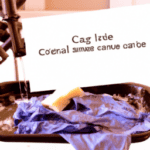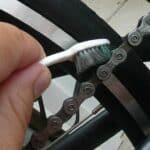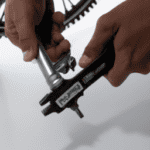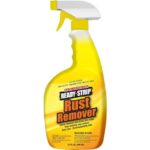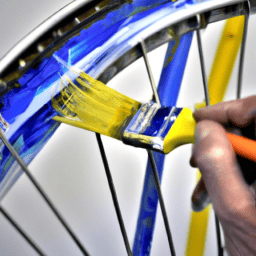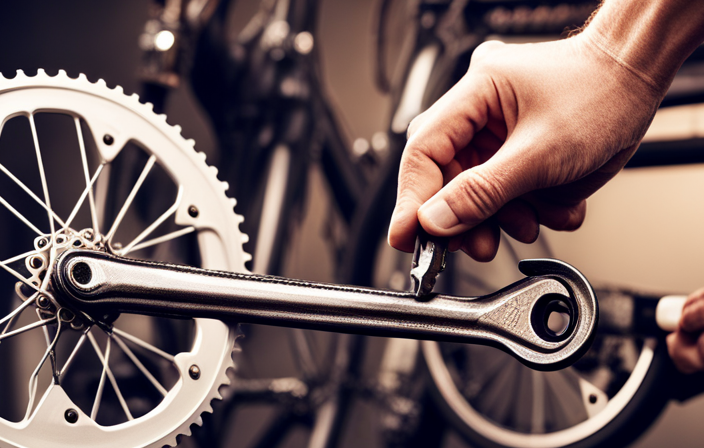Fed up with getting your outfits spoiled by unpleasant bike grease marks? It doesn’t matter if you’re an experienced rider or a newcomer to cycling, getting grease stains on your clothing is a frequent issue.
But don’t worry, with the right tools and techniques, you can easily remove these stains and keep your clothes looking like new.
First, it’s important to identify the type of stain and fabric you’re dealing with. Different fabrics require different treatment methods, and some stains may require extra attention.
Once you’ve determined the type of stain and fabric, you can pre-treat the stain with the appropriate solution, launder the clothes, and finally dry them.
With a little bit of effort, you can say goodbye to those pesky bicycle grease stains for good!
Key Takeaways
- Different fabrics require different treatment methods for grease stains, with cotton being easier to clean than synthetic fabrics like polyester or nylon.
- Pre-treating the stain with dish soap, baking soda and vinegar, or a commercial stain remover can be effective.
- Synthetic fabrics like polyester or nylon are more difficult to clean due to their oil-resistant properties, and some fabrics may require professional cleaning to avoid damaging the garment.
- Regularly cleaning and lubricating the bike chain can prevent excess grease buildup, and wearing protective clothing can prevent grease from getting on clothes and prevent injuries while biking.
Identify the Stain Type and Fabric
So, you’ve got bicycle grease on your favorite shirt? Let’s first identify the stain type and fabric so we can tackle this issue with ease!
Different fabrics require different types of stain removal techniques, so it’s important to know what you’re dealing with. Cotton, for example, is a common fabric that is durable and absorbent, making it easier to remove stains from. On the other hand, synthetic fabrics like polyester or nylon are more difficult to clean due to their oil-resistant properties.
When it comes to stain removal techniques, the type of fabric makes a big difference. For cotton, you can use a pre-treatment solution and wash the garment in hot water. For synthetic fabrics, you’ll need to use a different approach such as using a degreaser or a solvent-based product.
It’s important to note that some fabrics may require professional cleaning to avoid damaging the garment. Now that you know your fabric type and stain removal options, let’s move on to pre-treating the stain.
Pre-treat the Stain
Now that you’ve identified the type of stain and fabric, it’s time to pre-treat the area. To do this, you’ll want to start by using dish soap to break down the grease. Apply it directly to the stain and let it sit for a few minutes before rinsing with warm water.
For tougher stains, try applying a paste of baking soda and vinegar and letting it sit for 15-20 minutes before rinsing. If all else fails, a commercial stain remover can be used according to package instructions.
Use Dish Soap
To tackle the grease stain on your clothes, grab some dish soap – it’s like a superhero that fights grime with ease! Dish soap is a miracle worker when it comes to grease removal hacks. It’s a simple and affordable alternative to cleaning methods that might require harsh chemicals or professional help.
Here are some tips to effectively use dish soap to remove bicycle grease stains from your clothes:
- Apply the dish soap directly to the stain and let it sit for at least 5 minutes.
- Rub the fabric gently with your fingers or a soft-bristled brush to work the soap into the fibers.
- Rinse the garment thoroughly with cold water, making sure to remove all soap residue.
Using dish soap is a quick and easy way to remove bicycle grease stains from your clothes. However, for tougher stains, you might need to apply baking soda and vinegar to break down the grease even further.
Apply Baking Soda and Vinegar
Using baking soda and vinegar together creates a powerful solution that can effectively eliminate stubborn stains from your garments. Baking soda benefits and vinegar hacks have been used for centuries to clean and disinfect various surfaces. When combined, the two ingredients create a chemical reaction that dissolves dirt and grime, making them perfect for removing bicycle grease from your clothes.
To apply this eco-friendly laundry solution, mix equal parts baking soda and vinegar to form a paste. Apply the paste directly onto the grease stain and let it sit for 30 minutes to an hour. Then, rinse the garment with cold water and wash it as usual. Not only is this method effective, but it’s also a great alternative to harsh chemical cleaners.
Transitioning into the subsequent section, if the grease stain persists, don’t worry! There are other solutions you can try. One of them is using a stain remover.
Try a Stain Remover
If you’ve tried the baking soda and vinegar method but still have a stubborn stain, a stain remover might be your best bet. Here are some stain remover alternatives that you can try:
-
Oxygen-based stain removers are great for removing grease stains. They work by breaking down the stain molecules and lifting them from the fabric.
-
Enzyme-based stain removers are also effective on grease stains. They contain enzymes that break down the proteins in the stain, making it easier to remove.
-
Solvent-based stain removers are another option. They work by dissolving the grease stain, making it easier to wash away.
-
If you prefer a more natural option, you can try using a mixture of lemon juice and salt. The acidity of the lemon juice helps break down the grease, while the salt acts as a mild abrasive to scrub the stain away.
Remember, prevention is key when it comes to grease stains. To avoid getting grease on your clothes, wear an apron while cooking or working on your bike. If you do get grease on your clothes, treat the stain as soon as possible to increase your chances of removing it completely.
Once you’ve successfully removed the stain, launder the clothes as usual to ensure they’re clean and fresh.
Launder the Clothes
Now that you’ve pre-treated the stain, it’s time to launder the clothes.
To ensure the grease is removed, wash the garment in hot water. Use a heavy-duty laundry detergent that’s designed to tackle tough stains like bicycle grease.
For added protection, consider using a stain-blocking solution to prevent future stains from setting in.
Wash in Hot Water
First, start by throwing your grease-stained clothes in the wash with hot water. Hot water is effective in breaking down grease and oil, making it easier to wash out of your clothes. It’s important to note that hot water should only be used on fabrics that are safe to wash in high temperatures. Always check the care label on your clothes before washing them in hot water to avoid damaging them.
While hot water can be beneficial for removing grease from clothes, there are also precautions that need to be taken. Hot water can cause some fabrics to shrink or fade, so it’s important to be cautious when washing clothes that are made of delicate or brightly colored materials. If you’re unsure about using hot water on a particular item, it’s best to err on the side of caution and wash it in lukewarm water instead.
Once you’ve washed your clothes in hot water, the next step is to use a heavy-duty laundry detergent to help remove any remaining grease stains.
Use Heavy-Duty Laundry Detergent
Using a heavy-duty laundry detergent will help obliterate those stubborn stains and leave your clothes looking fresh and clean, ready to wear with confidence. When searching for a detergent, look for one that’s specifically labeled as heavy-duty or designed for stain removal.
Here are some laundry tips to keep in mind:
- Use the recommended amount of detergent according to the instructions on the label.
- Pre-treat the stain with the detergent by rubbing a small amount directly onto the affected area before washing.
- Let the detergent sit on the stain for a few minutes before washing.
- Wash the clothes in the hottest water recommended on the care label.
- Rinse the clothes thoroughly after washing to ensure all detergent residue is removed.
Clothing maintenance is essential to keeping your clothes looking their best. By using a heavy-duty laundry detergent and following these laundry tips, you can remove stubborn bicycle grease stains and keep your clothes looking fresh and clean. Consider a stain-blocking solution for extra protection against future stains.
Consider a Stain-Blocking Solution
To take extra precautions against future stains, you can consider using stain-blocking products that work by creating a barrier between the fabric and any potential stains. These products are typically applied to the fabric before washing and can provide a protective layer against grease, oil, and other types of stains.
Some stain-blocking products come in spray form, while others are added to the washing machine during the wash cycle. If you prefer DIY alternatives, you can try using common household ingredients such as vinegar or baking soda to create a natural stain-blocking solution. Simply mix one part vinegar or baking soda with two parts water and apply to the stain before washing.
These solutions are gentle on fabrics and can also help to remove any lingering odors. Once you have applied the stain-blocking solution, it’s important to allow the clothes to dry completely before attempting to wash them again.
Dry the Clothes
Once the clothes have gone through the wash, you’ll want to throw them in the dryer to ensure that all the grease has been removed and the fabric is fully dry.
Here are some tips to consider when drying your clothes:
-
Use a high heat setting. This will help to further break down any remaining grease and ensure that it is fully removed from the fabric.
-
Add a dryer sheet. This will help to soften the fabric and remove any lingering odors from the grease.
-
Check the clothes periodically. It’s important to check the clothes periodically to ensure that they are drying properly and not getting overheated.
-
Avoid air drying. Air drying can lead to the grease setting into the fabric, making it much harder to remove. Instead, opt for the dryer to fully remove the grease and ensure that your clothes are fully dry.
Once your clothes are fully dry, you can move on to additional tips and tricks for getting rid of any remaining stains or smells.
Additional Tips and Tricks
Now that you’ve completed drying your clothes, let’s explore some additional tips and tricks to tackle stubborn stains and odors. Stains can be a pain to remove, but there are some hacks that can make the process much easier. For example, if you have a grease stain on your clothes from your bike chain, try using dish soap to break down the grease before washing. Apply a small amount of dish soap to the stain and gently rub it in with a toothbrush. Let it sit for a few minutes before washing as usual. This method should help remove the grease stain and leave your clothes looking fresh and clean.
In addition to stain removal hacks, there are also some grease-free bike maintenance tips you can use to prevent future stains on your clothes. One tip is to regularly clean and lubricate your bike chain to prevent excess grease buildup. Use a degreaser and a brush to remove any dirt and grime from the chain, then apply lubricant to keep it running smoothly. Another tip is to wear protective clothing, such as a bike chain guard or pants clip, to prevent grease from getting on your clothes in the first place. By following these tips, you can keep your bike in top condition and your clothes stain-free.
| Stain Type | Solution |
|---|---|
| Grease | Dish Soap |
| Sweat | Baking Soda Paste |
| Blood | Hydrogen Peroxide |
Frequently Asked Questions
Can I use regular laundry detergent to remove bicycle grease stains?
Yes, you can use regular laundry detergent to remove bicycle grease stains. However, for tougher stains, try using household items such as baking soda or vinegar. If all else fails, consider professional stain removal services.
Is it safe to use bleach on clothes with bicycle grease stains?
Using bleach on clothes with bicycle grease stains is not recommended since it can damage the fabric and make the stain worse. Instead, try eco-friendly stain removers or bleach alternatives like hydrogen peroxide or vinegar.
How long should I let the pre-treatment solution sit on the stain before laundering?
To effectively remove grease stains, it’s important to properly pre-treat the stain and use the correct laundry techniques. Let the pre-treatment solution sit on the stain for at least 10 minutes before laundering. To prevent future stains, avoid contact with grease and use protective clothing.
Will using hot water during the washing process help remove the stain better?
Yes, using hot water during the washing process can help remove stains more effectively. However, the effectiveness of pre-treatment solutions should not be overlooked as they are also important in removing tough stains.
What types of fabrics are more susceptible to permanent damage from bicycle grease stains?
Fabric selection is crucial in avoiding permanent damage from bicycle grease stains. Synthetic fabrics like polyester are more susceptible, while natural fibers like cotton and wool are more resistant. Stain prevention methods should also be considered.
Conclusion
Congratulations! You’ve successfully removed that pesky bicycle grease stain from your clothes. You’re now a laundry master, capable of tackling any tough stain with ease. Your friends and family will be amazed at your newfound stain-fighting skills.
But wait, there’s more! With these tips and tricks, you can now confidently take on any stain that comes your way. You’re a stain-removing superhero, capable of saving clothes from the clutches of dirt and grime. Your laundry game has been elevated to a whole new level.
So go forth, laundry warrior, and fear no stain. With your new knowledge and skills, you’re unstoppable. Your clothes will thank you, and you’ll feel a sense of pride and accomplishment every time you successfully remove a stain.
Keep up the good work, and happy laundering!


